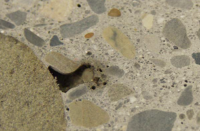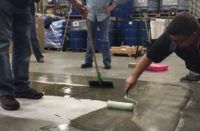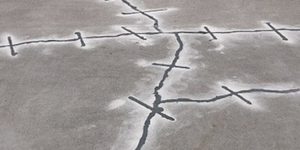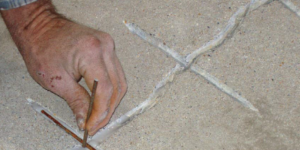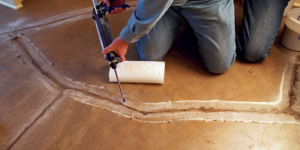
When I first got into the concrete business, a very revered contractor shared some sage advice. He said, “David, there are only three things you can guarantee a customer when you’re working with concrete. No. 1: Concrete will always get hard. No. 2: No matter what you do, concrete will crack. And No. 3: Concrete won’t be stolen.”
Almost 20 years and thousands of projects later, these three rules still apply. Concrete cracks whether you want it to or not. Engineers spend their entire lives dedicated to trying to get concrete slabs and walls to crack where they want. Every set of specifications you look at and every set of architectural plans you see have pages dedicated to concrete cracking.
For this article, my goal is to help you better understand cracking when it comes to concrete. I hope to help you prepare your customers for potential issues by shedding some light on how to handle these issues when they happen.

Shrinkage cracking
There are basically three types of everyday cracking. The first and most common, is shrinkage cracking. When concrete is placed, it is a liquid. You must keep it a liquid to get it to form into the shape you want. With the right water-to-cement ratio, you can get a liquid that flows. This makes it easier to push out of a truck or pump to an intended spot.
The amount of water added is tightly controlled. There is a constant battle between the supplier that has promised the concrete will get to a certain strength or hardness, and the placement contractor whose job it is to get the wet gray material out to the middle of a slab and get it flat. The supplier wants it drier because that helps achieve strength and the placement contractor wants that mud wetter because it makes it much easier to get it into place.
The key point to understand in relation to cracking is that water is a certain percentage of the concrete mix. Any material that contains water will shrink as it dries and the water evaporates. Concrete is no different. A typical 4-inch slab will shrink at least ¼ inch for every 100 sq. ft. of surface space.
This shrinkage causes several issues. The two main ones are cracking and curling. In this article, we’ll only focus on cracking. As the shrinkage begins, the concrete will crack where it is the weakest. Cracking typically starts within 12 hours of the finishing process. Weather conditions will slow or accelerate it. Shrinkage cracking is typically planned for and handled with control joints.
One way to handle cracks in concrete is by using control joints. Control joints are designed cuts that go at least halfway through the thickness of the concrete slab. These are intended to cause weakness so that the concrete cracks along the bottom of the control joint which releases the stress from the evaporating moisture. These joints are typically spaced evenly through a project.
I typically see control joint placement across the slab with the cuts forming squares that are 10-by-10 or 15-by-15-feet wide. If the spacing between these control joints is larger, even if the concrete follows the control joint pattern, you end up with extremely wide joints that become harder to fill and maintain. Over time with traffic, the edges of wide joints break easier, creating safety issues. Larger sections also have a greater chance to crack in unintended locations.

Structural cracking
The second most common type of cracking is structural cracking. Although I’ve seen it many times in new buildings, structural cracking doesn’t typically occur there. It tends to be more prevalent in older structures.
The pressure of a building is controlled by the weight of the structure and the wind. Over time structures settle and outside influences, like broken pipes or hurricanes, cause pressure to build up in certain points throughout the structure.
One of the first places these stresses are relieved is in the concrete. Here the one thing that makes concrete valuable, its strength, is its greatest weakness. Because the concrete cannot flex, it must crack. These cracks show up in a variety of widths and directions. I often see elevation variances where one side of the crack is higher than the other. Structural cracks can become tripping hazards when the height variance becomes too high or the crack spreads too wide.

There are several ways to repair these cracks. In my specifications, I recommend repairing them based on the facility’s usage. If a crack is ¼ inch wide and in an industrial environment where heavy forklift or vehicle traffic will be going over the crack, I recommend chasing the crack with a wider blade and filling the crack with a high-strength repair material. This keeps the smaller cracks along the edge of the larger crack from spreading.
This method works well, but often highlights the cracking. When we find a ¼ inch wide crack in a retail environment where light cart traffic and foot traffic are typical, I ask the contractor to clean the crack and inject filler (color matched to the surrounding concrete) into the space without chasing the crack. This method typically stops the crack from getting larger or spreading in the light traffic environment, without calling attention to the crack.
Craze cracking
“Craze cracking” is the third most common type of cracking, and the one that seems to frustrate customers the most. This crack is purely aesthetic. Some call it “alligator skin cracking” or map cracking.” It only affects the surface skin of the concrete without creating any structural issues.

This type of cracking typically covers a large area and has very fine veins in the surface. The concrete’s skin drying faster than the inside of the slab caused this. In turn the moisture trapped underneath results in its flex. This usually occurs when dry, hot or windy conditions occur during the placement of a slab.
I often use an analogy of the crust on bread when explaining this to customers. The outside cooks faster than the inside and then cracks when the inside expands. You can easily see these cracks if you slightly push an uncut loaf of bread together from the ends.
Because it covers a larger area, and because it is so visible, customers tend to be most frustrated about craze cracking. Typically, the cracks will appear white against the darker gray of the troweled slab finish.
I recently had a high-end clothing store customer get extremely frustrated because another subcontractor opened a back door and left it open after the concrete was poured into an area. The wind rushing through the open door caused cracking on the back 25 percent of the store. This was a polished concrete project, so these cracks were extremely visible. To fix this, we attempted to grind slightly deeper and grout the area. This was partially successful but some cracking remains.
Years ago, I stumbled on a technique that has helped many times with craze cracking issues. Customers tend to find light or white-colored cracks more upsetting than dark ones. I figured out if I used a water-based dye (slower penetration than acetone-based dyes) and sprayed the area with the cracks, I could let the color sit for about 60 seconds and then shop vac the area. This can be a very effective way to handle concrete cracks.

The only thing that took the color, due to the short dwell time, was the cracks. The smooth concrete didn’t have time for the water-based dye to penetrate. This process basically “antiqued” the cracks so they were darker and became a feature rather than a frustration. The hard part is when retailers start asking how they can intentionally cause this cracking because of the antiqued look.
There’s no disappearing act
The research about all three of the types of cracking and their causes in this article is extensive. If you go to the websites of the American Concrete Institute or the American Society of Concrete Contractors, you’ll find a lot of very useful information on how to handle concrete cracks.
If you’re a decorative concrete contractor, always remember you didn’t do anything to cause the cracks. They are a natural part of concrete curing and getting hard. There are very good repair options to keep cracks from getting worse, but no good method for making them go away. When it comes to how to handle cracks in concrete, preparing your customer ahead of time will be in your best interest.
By preparing your customer ahead of time with potential repair options, you can head off a lot of frustration and headaches. Remember, concrete — just like any other stone — gets hard and cracks.

